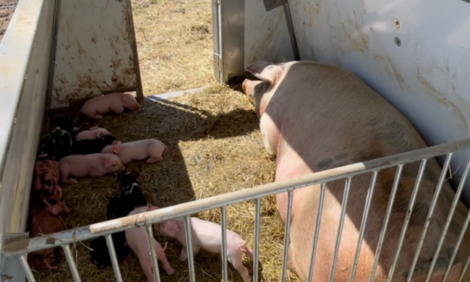



Initial results of field vaccination against Ileitis in Belgium
By Boehringer Ingelheim Vetmedica, Inc. - Boehringer Ingelheim's new vaccine against ileitis (also known as PIA) has been on the Belgian market since October 2005 and the first results from field use of the vaccine are now available. With the aid of slaughterhouse data from the Beirnaert-Ghekiere herd in Noord-schote, we take a detailed look at the impact of the new vaccine on this economically important disease.Disappointing feed conversion efficiency
When the corrected feed conversion efficiency of his contracted fattening pigs regularly started to rise above 2.9 - and occasionally well above 3 - Michel Beirnaert knew it was time to take action. At the suggestion of Dries Ghekiere of Ypres-based feed supplier Delva and after consultation with his herd vet, Michel decided to have his pigs screened for ileitis. It was the right way to go. The results gave a clear picture of how PIA had taken hold on his premises. It was decided that a trial of the new vaccine was warranted.
 Michel Beirnaert and Rita Ghekiere run a herd of 360 France Hybride sows in Noordschote (Lo-Reninge). They started up the herd in 1983 and fatten their piglets on contract. Their productivity parameters last year were as follows: Pigs weaned per sow per year: 23.7; litters per sow per year: 2.28; farrowing losses: 9.5%; post-weaning mortality: 2.5%. Their son Peter is being groomed for the succession. |
Field trial
Michel sends his piglets under a guaranteed-price contract to two fattening herds and has therefore been keeping a close eye on the slaughterhouse data for these herds for some considerable time. The use of fully segregated housing and separate silos means that growth rate and feed conversion efficiency in the various groups can be closely monitored. The herd was therefore especially well suited for a field trial, which was duly started in June 2005.
Time of infection determines method of vaccination
The new vaccine can be administered to piglets via the drinking water or by oral drench.
"In the drinking water method, the vaccine is added to a milk/wa-ter mixture containing 3% of milk, with 200 ml of the mixture be-ing required per piglet," says Peggy de Backer of Boehringer In-gelheim, the firm that manufactures the vaccine. "The mixture is normally poured into the drinking trough in the weaner nursery. Since the pigs were kept in groups of 10 in this case, each trou-gh was filled with 2 litres of the mixture made up in a measuring jug."
"We vaccinated 160 pigs every week and it barely took us 15 to 20 minutes to do the lot," says Rita Ghekiere, testifying to the fact that the drinking water method is far from labour-intensive. However, since the vaccine is a live one, it is important that pigs do not receive antibiotics in the period surrounding vaccination. Hence, the drinking water method is recommended for herds contending with a late infection of ileitis.
 Some 160 pigs were vaccinated every week via the drinking water. Because the pigs were kept in groups of 10, a sin-gle 2-litre measuring jug containing the prescribed mixture of milk, water and vaccine was enough for each drinking trough. The whole batch of 160 took barely 20 minutes to vaccinate. |
Higher carcase weights and greater weight uniformity
Michel's piglets were vaccinated using the drinking water meth-od about 10 days after weaning. Thanks to the ready co-operation of the Covavee and Westvlees slaughterhouses, detailed results were soon available.
The results from the two fattening herds were summarised in two graphs. The blue curves show the situation before vaccination, whilst the red ones show the situation after vaccination. In herd 1 the mean carcase weight rose from 93.3. to 97.2 kg (+ 3.9 kg), whilst in herd 2 the mean carcase weight rose from 88.6 to 96 kg (+ 7.4 kg).
A striking feature of both graphs is that the red curve is narrower than the blue one. "This shows that there was greater weight uniformity in both groups after vaccination," says Peggy de Backer.
Conclusion
Michel and Rita, meanwhile, have decided to make vaccination against PIA a permanent feature of the heal-th measures on their farm. "We're very satisfied with the effect the vaccine is having on both overall growth and weight uniformity," concludes Michel.
| FATTENING HERD 1: | FATTENING HERD 2: |
| Carcase weights BEFORE and AFTER vaccination Slap mark: NLXP Animals slaughtered between 15.6.2005 and 16.12.2005 |
Carcase weights BEFORE and AFTER vaccination Slap mark: 66X6 Animals slaughtered between 3.7.2005 and 20.1.2006 |
 |
 |
 |
 |
Further Information
Read more about: Enterisol® IleitisBoehringer Ingelheim Vetmedica, Inc.
Source: Boehringer Ingelheim Animal Health - April 2006








